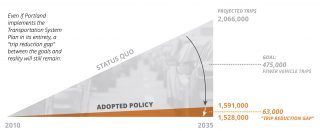PBOT report finds bike infrastructure key to e-scooter utilization

They’re not simply bike lanes anymore.
(Picture: Metropolis of Portland)

Report cowl.
The winding street of shared electrical scooters in Portland has taken one other flip. At the moment the transportation bureau launched a report (PDF) on scooter utilization and outlined plans for a everlasting system. Among the many findings is that cycling-specific infrastructure is vital to boosting scooter ridership, particularly in locations with high-stress streets like east Portland.
Portland launched e-scooters in summer 2018 as a pilot program. The Portland Bureau of Transportation deemed them successful and launched a second pilot in spring 2019 that’s set to finish on December thirty first.
With classes discovered in courtship and constructive indicators that the scooters are a wanted and priceless a part of Portland’s transportation ecosystem, PBOT desires to quiet down with fewer companions and a longer-term dedication. There are at present six completely different corporations providing scooters in Portland. That is clunky for each customers and PBOT employees to handle. A key advice within the report launched at present says PBOT desires to work with 1-3 corporations for the subsequent 2-3 years.

Construct it and they’re going to scoot.
Among the many takeaways within the report is the influence of motorcycle infrastructure on scooter utilization. Not solely did PBOT discover that the presence of motorcycle lanes led to a lot much less sidewalk-scootering, GPS knowledge reveals 32% of all scooter mileage occurred on protected bike lanes, unprotected bike lanes, bridge bikeways, paths, and/or neighborhood greenways. “E-scooter riders really feel extra comfy when there’s secure infrastructure to journey separate from automobiles,” states the report.
PBOT was additionally capable of evaluate how ridership knowledge modified with the development of motorcycle infrastructure that was constructed between the primary and second pilots. In Waterfront Park as an illustration, the construction of Better Naito in 2019 led to a 55% enhance in using on Naito and a subsequent 45% lower on the park path (this additionally needed to do with signage warning individuals to remain out of the park and a few “geofencing” from scooter distributors).
The new protected bike lanes on the Halsey-Weidler couplet in Gateway additionally seem to have impacted scooter utilization. PBOT evaluation reveals a 125% enhance in journeys between 2019 and 2018. And on 102nd the place new bike lanes were installed, there was a 22% increase in ridership. These will increase come at the same time as general e-scooter ridership was decrease in 2019 than 2018.
These findings present that biking advocates can be clever to embrace scooter riders so as to strengthen and diversify their push for extra devoted infrastructure. “Bicycling is usually related to white-dominant tradition,” PBOT writes within the report, “and e-scooters could or could not share that affiliation.”
Chosen graphics from the report
The advice of a everlasting program makes it clear the Metropolis of Portland sees scooters as an integral a part of the modal combine.
Whereas some scooter journeys change bike journeys, knowledge reveals that scooters fill a special want: The common journey size for e-scooter riders is simply over one mile and fewer than 14 minutes; the common (non-electric) bike share journey is over two miles and 25 minutes.

With the local weather change disaster staring us straight within the face nowadays, PBOT additionally sees scooters as a key method to cut back automotive abuse. Town’s Transportation System Plan requires 475,000 fewer every day automotive and truck journeys by 2035. Nevertheless even when we succeed with adopted plans, we’ll nonetheless give you a “journey hole” of 63,000 every day journeys (see graph at proper). “If new mobility providers like e-scooters can present a sexy choice that reduces automotive use and automotive possession, they could assist shut this ‘journey hole’ and meet metropolis congestion and local weather targets,” states the report.
And naturally e-scooter journeys are way more earth-friendly than automotive and truck journeys. PBOT estimates scooter riders have helped Portland decrease carbon emissions by 167 metric tons and have eliminated the equal of 27 passenger automobiles and vehicles from the streets over the 2019 pilot interval.
Together with the report, PBOT launched a scooter knowledge dashboard and survey. Get all the data and hyperlinks here.
 hotebike
hotebike